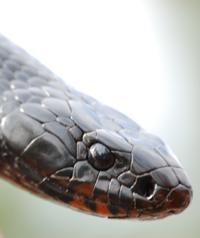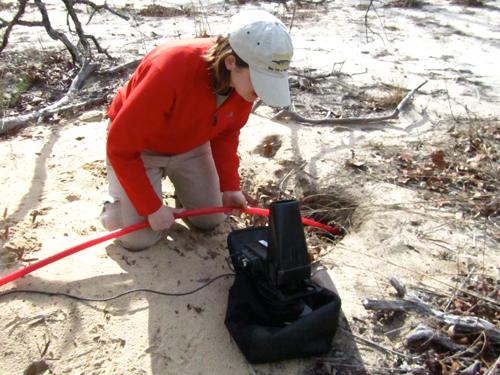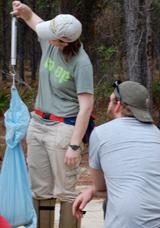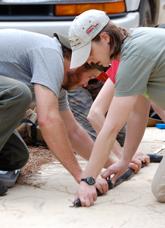Looking for Indigo Snakes in Georgia
By Lauren Augustine, Reptile Discovery Center Keeper at the National Zoo
Eastern indigo snakes, Drymarchon couperii, are the largest nonvenomous snake in North America. They live in a variety of habitats depending on the region. They are beautiful, uniformly black but in sunlight they are remarkably iridescent, with a wash of bright orange-red on their chin area (see photo to the left). The northern part of their range includes southern Georgia where the snakes use gopher tortoise, burrows to escape the cold in the winter. These large-bodied snakes eat a variety of vertebrates, using their considerable size and strong jaws to overpower its prey.
The Orianne Society is a wildlife conservation organization working to save the threatened eastern indigo snake. This organization was founded in 2008 in response to a little girl’s infatuation with an indigo snake she was given the opportunity to hold. Following her encounter with this beautiful reptile, she asked her father if he could do something to save them. As a result, the Kaplan family created the Orianne Society to save the eastern indigo snake. Now using the eastern indigo snake as their flagship species, they work nationally and internationally to conserve reptiles and amphibians. They use their conservation work with the indigo snake as a model for other initiatives such as their pit viper conservation program focused on the eastern diamondback rattlesnake.
The Smithsonian’s National Zoo’s Reptile Discovery Center recently sent several Animal Keepers to Georgia to collaborate with Orianne Society staff. Each keeper spent about a week working in the field with the Orianne Society’s seasonal field biologist Andy Day and their Director of Inventory and Monitoring, Dirk Stevenson.
The most recent trip was in February of 2012, and I was fortunate enough to participate along with two other NZP staff members. We conducted daily surveys of known indigo habitat hoping to catch a glimpse of these striking snakes. In early spring, these snakes are just coming out of their dens to bask in the sun, hunt, and find a mate. They are constantly moving in and out of their dens to regulate their body temperature. They can be tricky to find, so looking for snake tracks is very helpful.
The field biologist Andy showed us several methods for figuring out the status of a burrow, including how to examine a den and determine whether a snake was in the den or if a snake had recently emerged. To determine if a burrow was occupied, we used hand mirrors to reflect the sun’s light into the tortoise burrows. Gopher tortoise dens can be very deep and extensive, so for deeper dens we used burrow cameras. Although we were only surveying the snakes we saw above ground, this camera helped to located tortoise burrows that were occupied by snakes for future surveys. If a snake had recently left a den, we could see a continuous line of horizontal sand around the entrance of the burrow. If they had returned to the den, the impressions would be flattened by the snake’s quick retreat.
Using the burrow cam
When dressing for the field, we wore long pants with hiking boots under our ankle-high gaiters. Gaiters are a type of leg armor commonly worn when working in areas with venomous snakes. They proved vital for trekking through the thorny bushes that sometimes covered the field sites as well as serving as extra protection against the diamondback rattlesnakes, which are commone in these areas. In additional to our attire, we each carried a mirror, snake hook, and either a pillow case or a hard plastic cooler with a latching lid for holding any snakes we caught.
During the first few days we didn’t find any indigo snakes, but we did happen upon a rattlesnake and some gopher tortoises with the burrow camera. At each site, we documented the temperature, cloud cover, and GPS coordinates of each burrow. We also marked each burrow with a pink ribbon to make the surveys more productive on return field assessments.
By mid-week, we had still not seen an indigo snake so we headed out to a site with Dirk to see if our luck would change. At this site, we met with a snake biologist from the University of Florida and the five of us started searching eagerly. By midday we had found a couple of rattlesnakes, and Dirk had seen an indigo that got away from him in the brush. We decided to change locations. We all piled in the trucks, drove a little further up the sandy Georgia back road and pulled over on the shoulder between two tracks of forest. We split into two groups and headed into the thick, prickly brush. After about twenty minutes we all heard Dirk calling: he had caught a large female indigo snake heading for her den.
After taking several photos of the beautiful snake we began to “process” (or collect data about) the snake. We weighed her, measured her and pit tagged her, since this was the first time she’d been captured by researchers. A pit tag is an identification device implanted in the body to internally mark each animal so that continuous data can be accumulated over time. These are commonly used in reptile fieldwork, as well as in zoological institutions when animals of the same species are housed together and have no distinguishing features. They are unique barcodes that individually identify each individual and are scanned by a reader from outside the animal’s body. Then we took a small scale clipping for genetic sampling and released the snake. We took the coordinates of her burrow moved on to another area of the site.
Weighing
Measuring
Pit-tagging
Once again we split into two teams to cover more ground and surveyed the area. After about 45 minutes, Dirk had captured another large female indigo snake. This snake was similarly processed and released, ending a successful day in the field. As the week progressed, we captured a total of three indigo snakes, located four eastern diamondback rattlesnakes and saw many tortoises in their burrows.
This trip was a valuable experience for RDC staff, who helped capture and process a total of five Eastern Indigo snakes this season. Observing and working with scientists in the field is always a wonderful learning experience that we all welcome. We look forward to using this information when designing the exhibit and implementing husbandry protocols for our incoming indigo snakes that are scheduled to arrive at RDC in the fall of 2012.
This story was originally published in May/June 2012 issue of Between the Lions, Friends of the National Zoo’s volunteer newsletter.
Related Species:







